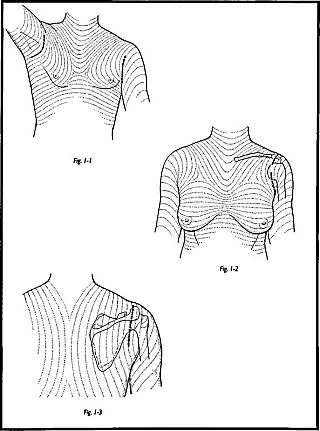Incisions around the Shoulder
Relaxed skin tension lines have been found to be more reliable than Langer's lines in assessing the optimum position for a cosmetic incision. Relaxed skin tension lines are determined at the time of operation by pinching the skin and observing the linear creases. The best defined lines occur when the skin is pinched perpendicular to the line of optimum incision. Skin lines vary between people and between men and women. It is believed that lines develop from stress caused by the convexities of underlying structure, with contributions from gravity and the motion of adjacent joints. The underlying convexities have the most influence on skin stress. The lines represent the orientation of the collagen in the underlying dermis, and they are important because the collagen and the healing wound aligns itself along the length of the incision, regardless of the orientation of the wound (Figs. 1-1 to 1-3).
A cosmetic incision may not be parallel to the underlying dissection. Skin tension lines are often formed at right angles to the long axis of the underlying muscles. In these circumstances, it is necessary to raise skin flaps while protecting the circulation of the skin. Anterior to pectoralis major, the skin is very mobile in relation to underlying muscle. Here, the dissection should be done on the superficial side of the deep fascia. It is not necessary or advantageous to take the deep fascia with the skin flaps, because a fascio-cutaneous flap offers no additional circulation to the overlying skin.
The skin over the middle third of the deltoid muscle is attached very tightly to the underlying deep fascia, and there is no relative motion between skin and muscle. The vessels pass vertically from the posterior humeral circumflex artery through the septa in the muscle to the overlying dermis rather than follow in an oblique course. Subfascial dissection offers no additional circulation to skin in this area; in fact, it offers a disadvantage of disturbing some of the overlying collagen of the deltoid muscle that is necessary for bony reattachment. When it is necessary to mobilize large areas of skin in other areas of the shoulder, as over the biceps muscle, it may be advantageous to take the deep fascia with the skin, because an extra layer of vessel is present on the superficial surface of the deep fascia.



